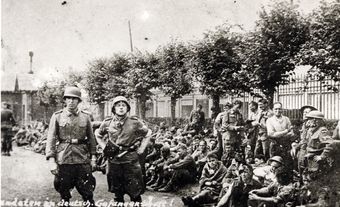
Early Life
David Currie was the son of a Canadian Pacific Railway engineer. His family moved to Moose Jaw, Saskatchewan in 1913, where he completed high school. At 14, he enrolled in the King’s Own Rifles of Canada, a local militia unit, and attended technical school, qualifying as a mechanic and welder. By 1939 Currie was a second lieutenant.
War Service
Currie joined the regular force in 1940, in the midst of the Second World War, as a lieutenant. He was promoted to captain the next year and posted to the reconnaissance training centre at Dundurn, SK. In November 1941, he was assigned to the Canadian Armoured Corps School at Camp Borden, Ontario, before being sent to the South Alberta Regiment (29th Armoured Reconnaissance Regiment), to help the unit convert from infantry to armour.
The South Alberta Regiment (SAR) went overseas in August 1942 in the newly-formed 4th Canadian Armoured Division. The SAR became the 29th Armoured Reconnaissance Regiment (The South Alberta Regiment) in December 1942. Currie was promoted to major in August 1943 and given command of C Squadron.
Following extensive training in England, the SAR landed in France on 24 July 1944, seven weeks after D-Day. Since those landings on 6 June, the Battle for Normandy had not gone well for the Allies, with progress much slower than predicted.
Courage at St-Lambert-sur-Dives
Days after the SAR landed, the American 1st Army broke out of the Normandy bridgehead and swung south of the German 7th Army. As the Americans turned north towards the town of Falaise, 4th Canadian Armoured Division moved south towards them, hoping to trap the German forces in Normandy in a giant vise. Currie’s squadron, with an attached company of the Argyll and Sutherland Highlanders and some self-propelled anti-tank guns, was told to block the German retreat through the village of St-Lambert-sur-Dives.
Finding the village occupied by Germans, Currie attacked it on the morning of 19 August and by noon had fought halfway through the village. During the next 36 hours, the Germans launched one counterattack after the other, but could not drive the Canadians out. The final counterattack came at dusk on 20 August, but was repulsed by Currie’s skilful defence. With the Germans in disarray — and despite heavy casualties among his own men — Currie ordered an immediate attack and captured the remaining half of the village, blocking any German escape route through it.
Currie returned to Canada in December 1944 as a lieutenant-colonel to promote Victory Bonds and generate other support for the war. He was awarded the Victoria Cross for his courage and leadership at St-Lambert-sur-Dives.
Life Post-War
After the war, Currie worked in the paper and logging industries in Québec. He was living in Montréal in 1960, when Prime Minister John Diefenbaker appointed him sergeant-at-arms for the House of Commons, a position he held for 18 years.
Memory
After Currie’s death in 1986, the armouries in Moose Jaw, SK, was renamed in his honour, along with an avenue in the city. Plaques commemorating his bravery are displayed in Queen’s Park in Toronto, in Owen Sound, ON (his place of burial) and in Victoria Cross Park, Calgary, Alberta.
His VC and other medals were sold at a British auction in September 2017 for an astonishing $660,000, one of the highest recorded prices.
Currie’s bravery is also commemorated on a plaque in St-Lambert-sur-Dives, France, overlooking the village road where hundreds of Germans surrendered to Currie in 1944. An iconic, black-and-white photograph happened to capture the moment. According to C.P. Stacey, the Canadian army’s official historian for the Second World War, the image is “as close as we are ever likely to come to a photograph of a man winning the Victoria Cross.”


 Share on Facebook
Share on Facebook Share on X
Share on X Share by Email
Share by Email Share on Google Classroom
Share on Google Classroom




